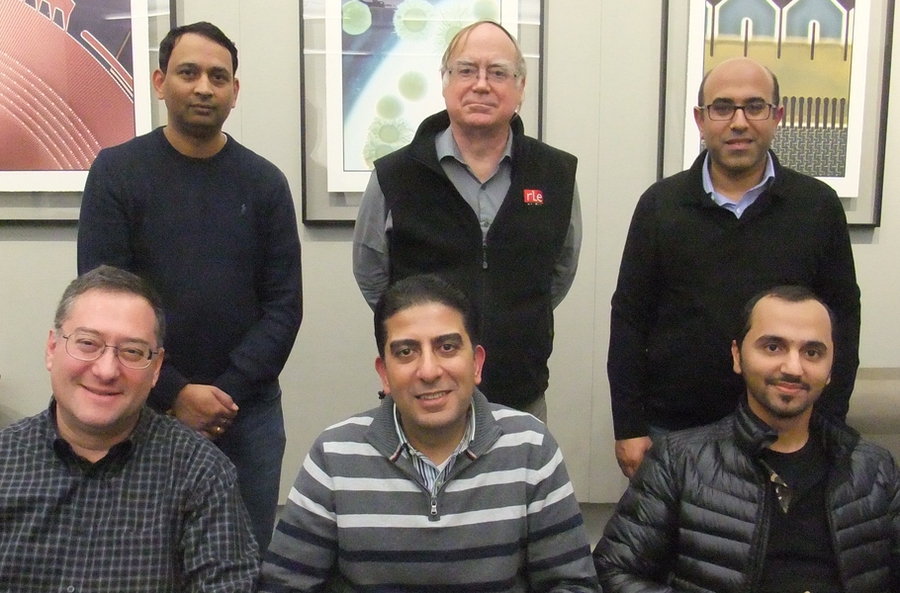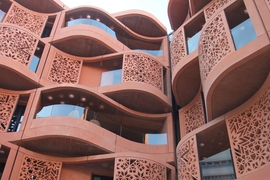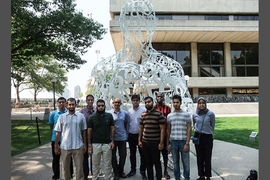Launching a world-class research university from scratch is a tall order — even for MIT. But in just a little over a decade, the Masdar Institute of Science and Technology grew from an idea to a thriving institution thanks in part to a rich, multifaceted relationship between MIT and Abu Dhabi. Today, that relationship continues to help students and faculty members from both universities produce world-class research while becoming better researchers and scholars.
“It’s been inspiring to see a university literally rise out of the desert,” says Steven B. Leeb, a professor of electrical and mechanical engineering at MIT who has been engaged with the Masdar Institute almost since its founding in 2007. “We’ve been involved with a ton of international university development efforts, and there are none more successful than this one.”
A little over a year ago, this relationship entered a new stage as Masdar Institute merged with two other Abu Dhabi universities (Khalifa University of Science, Technology, and Research, and the Petroleum Institute) to become Khalifa University, an entity that opens new horizons for the MIT collaboration.
“We’re excited about this merger because it really broadens our opportunities for working together,” says Professor Duane Boning, director of the MIT and Masdar Institute Cooperative Program (MIT&MICP). “Khalifa is a bigger institution with more students, including undergraduates, and more resources — which is invaluable to MIT students and faculty who spend time there. So, this collaboration has a great chance to deepen even further.”
Over the past 11 years, MIT&MICP has supported 93 research projects, leading to more than 400 publications in peer-reviewed journals. The program’s education and research activities have involved 270 faculty, postdocs, and research scientists from 26 MIT labs and centers. In addition, 346 MIT master’s and PhD students have participated in the program, with more than 300 exchange visits taking place between Masdar Institute and MIT. Ninety-nine MIT faculty have served on Masdar Institute PhD committees, and 31 MIT faculty have reviewed Masdar Institute master of science theses.
Those involved in MIT&MICP describe the experience as transformational. “Being here accelerates my learning because I am in a highly competitive environment among people knowledgeable in fields beyond what I’m working on,” says Mouza M. Al Kaabi, a visiting Masdar Institute student who has come to MIT for a semester through MIT&MICP to work on her PhD in interdisciplinary engineering. “If I blink, I’ll miss something. It’s exciting.”
Masdar Institute faculty members say that working collaboratively with MIT faculty through MIT&MICP has accelerated their professional growth. “We developed our curriculum and courses with help from MIT. That’s why we have a successful program at Masdar Institute. It’s competing internationally,” says Mohamed El Moursi, an associate professor of electrical and computer engineering at the Masdar Institute. “There’s been remarkable achievement over the years, including international recognitions.”
Professor Hatem Zeineldin has worked with MIT for a decade — from his days as a newly appointed Masdar Institute faculty member to today as professor and interim senior director of Masdar Institute. He particularly credits his long-term professional relationship with Professor James L. Kirtley Jr. of MIT’s Department of Electrical Engineering and Computer Science with furthering his career. “Professor Kirtley is very special. … He is willing to share all the experience he has, which is very important for a successful collaboration.”
Zeineldin began working with Kirtley on a MIT&MICP-sponsored one-to-one project in 2007, which included a year-long posting to MIT. That project, which focused on the integration of renewable energy into power systems, led to several well-received publications. “I was an assistant professor just starting my career, and definitely that initial one-to-one project was very helpful,” Zeineldin says.
Since that time, Kirtley has provided Zeineldin with research mentorship, teaching insights, and advice on departmental leadership. “Heading a department here, I wanted it to be the best possible — like MIT — so I would frequently seek advice from Professor Kirtley,” Zeineldin says.
For his part, Kirtley says he travels to Masdar Institute almost every year and enjoys mentoring students, advising theses, and collaborating with Masdar Institute faculty members. In the past 11 years, he has participated in a variety of MIT&MICP research projects, ranging from investigating the stability of wind turbines to modeling the functioning of microgrids.
“I think that it’s the regularity of the contact that’s been helpful,” Kirtley says. “Clearly the academic enterprise does rely on regular contact with colleagues … [so] this connection with MIT is helpful in facilitating contact with the rest of the world.”
El Moursi agrees. “Most of the faculty here at Masdar Institute have published in top journals. Our projects in cooperation with MIT have made significant contributions to the field with high-quality publications,” he says.
El Moursi offered special thanks to Kirtley for his “remarkable professional support and wonderful collaboration with the power group” and noted, for example, that Kirtley got him involved with the Institute of Electrical and Electronics Engineers (IEEE), the main professional society in power electronics. Today, El Moursi is an editor and regional editor for several top-tier IEEE Transactions and Institution of Engineering and Technology journals.
Kirtley has helped several Masdar Institute faculty members connect to the broader power systems community, according to Zeineldin. “He doesn’t just participate in joint research but has provided recommendations for posts in the professional community,” Zeineldin says. “When you go to conferences, he introduces you to other members within his network of academics.”
For PhD students from Masdar Institute, spending time at MIT provides an opportunity to take courses not available at their home institution. Within the power systems area, for example, MIT offers a wider range of optimization subjects, including a class focused on electricity markets and regulations, Zeineldin says.
Al Kaabi of Masdar Institute says MIT has given her the chance to dive more deeply into urban planning than was possible at Masdar Institute. “This is chance for me to catch up on a lot of knowledge that the curriculum at home doesn’t provide,” she says.
The time at MIT has also provided Al Kaabi with networking opportunities. For example, during one MIT class she became acquainted with a representative of the U.N. Human Settlements Programme. That person later asked her to participate in a U.N. Habitat Workshop on Sustainable Infrastructure designed for Saudi Arabia professionals. “This is the kind of thing you can’t quantify. However, these things happen when you put people in this kind of environment. It’s a fertile ground for opportunity,” Al Kaabi says.
The Masdar Institute-MIT connection is not a one-way street, however. Leeb of MIT has offered a workshop at Masdar Institute almost every year and says, “Teaching at Masdar Institute has been very stimulating and has affected my teaching here at MIT.”
For example, Leeb presented a workshop at Masdar Institute for faculty members, graduate students, and undergraduates in which attendees learned to build a laser communicator using circuit boards and cell phones. Since then, Leeb says he has been using the same project in a freshman seminar at MIT. “The cross-fertilization has been wonderful.”
That laser workshop was a precursor to a flagship project sponsored by MIT&MICP to develop power systems for use in space. Begun in November 2017, Multi-Use Space Energy Systems (MUSES) aims to address several key power system challenges: providing reliable and stable operation; reducing the weight, cost, and size of components; and detecting, isolating, and recovering from malfunctions. MUSES involves Kirtley and Leeb from MIT as well as Zeineldin and El Moursi, among others from Masdar Institute.
The laser workshop gave faculty and students the chance to have some fun while addressing the challenge of space communication. It is another example of how Masdar Institute and MIT collaborators combine their research interests with teaching in unusual ways, Leeb says. “That’s why I love this team — there is joy on both sides for doing things that are kind of out of the box.”
Through these kinds of interactions and more, MIT&MICP has fostered not only research but also the intellectual development of the next generation of professors, government leaders, entrepreneurs, and innovators, according to those involved. As an example, several Masdar Institute graduates have been admitted to MIT’s PhD program. “We are very proud that MIT has accepted our product to be PhD students in its labs,” El Moursi says. “This shows the success of the program and the extent of mutual collaboration between MIT and Masdar Institute.”
Leeb agrees. “More than half the value of what we do isn’t the thing we make, it’s the person we train while we’re making it. Those people become part of the economy, the space center, and industry.”









